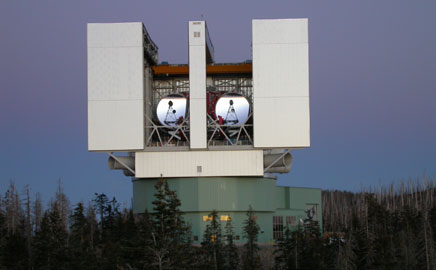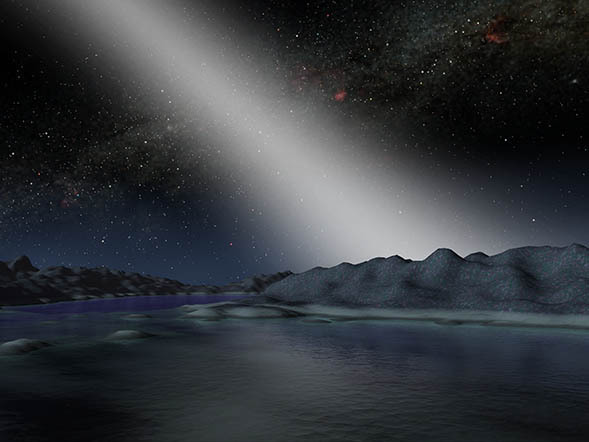
LBT atop Mt. Graham

Credit: NASA JPL
The design of a future space mission to use direct imaging to detect and characterize Earth-like planets around nearby stars demands a good understanding of the level and morphology of exo-zodiacal dust emission around the target stars. The Large Binocular Telescope Interferometer (LBTI) an instrument on the Large Binocular Telescope (LBT) on Mount Graham, Arizona, will advance the sensitivity to exozodiacal emission by a factor of 30 or more compared with earlier studies with the Spitzer Space Telescope and the Keck Interferometer.
The LBTI is part of NASA's strategic goal to find planets and ultimately life beyond our solar system. NASA funds the LBTI and the key science project (HOSTS - Hunt for Observable Signatures of Terrestrial Systems) to survey the exo-zodi dust levels around a sample of 50-100 nearby Sun-like stars, prime targets for a future exo-Earth direct imaging mission.
An independent review committee selected six investigators who will join the LBTI-HOSTS key science team. The LBTI-HOSTS science team is led by the LBTI Principal Investigator Phil Hinz (U. Arizona), and also includes LBTI Instrument Scientists Andrew Skemer and Denis Defrere (U. Arizona) and NASA-LBTI Project Scientist Rafael Millan-Gabet (NExScI). The LBTI-HOSTS science team is responsible for all aspects leading to the optimum execution of the exo-zodi key science program.

While the LBTI survey can be considered as a stand-alone result, comparison with related observations will undoubtedly aid with interpretation and understanding. The objective of this proposal is to use the combined LBTI/Spitzer/Herschel dataset to explore and quantify how observations at different wavelengths are related, how exozodiacal dust relates to cold outer debris, and how warm dust is related to neighboring planets.

I propose a set of strategies to maximize the science return and minimize risk for the LBTI, covering the following areas: (1) Instrument performance verification and optimization of observational efficiency; (2) Source selection for a "pilot" survey and high value early science targets; (3) Calibration, Pipeline, preliminary data analysis, and modeling; and (4) Source selection for the "complete" survey.

Measuring individual star exozodi emission levels -or upper limits- down to the 10 zodi level, a factor 30 better than the current state of the art, is the challenging and exciting task awaiting the LBTI team. With that ultimate goal in mind, we propose here to assist with 5 key aspects of the LBTI Exo-zodi Key Science survey: (i) the optimization of the nulling interferometry instrumentation, (ii) the selection of LBTI target stars, (iii) the high accuracy calibration of null data (in particular the exploration of systematics), (iv) the "inversion" of null data, and (v) follow-up observations of a subset of the targets.

I propose to contribute to the LBTI Exozodi Key Science project in the areas of target selection, observation planning, modeling of detected emission, and scientific interpretation. My experience studying disks with Hubble, Spitzer, Herschel, and WISE has given me unique knowledge of existing datasets. I am eager to assess the implications of median exozodi levels on the science requirements for the 2020s "New Worlds" exoplanet imaging mission.

We offer extensive experience observing disks with a wide variety of techniques, telescopes, and wavelengths. We will provide our insights into target selection, from the perspective of both the science and of the exoEarth mission requirements. We also propose to tackle the critical Science Team function of correctly connecting the LBTI observables to dust parameters that actually affect direct exoEarth observations. Finally, we propose to incorporate LBTI measurements of warm habitable zone dust into whole system architectures.

In addition to contributing to the survey definition, my primary contribution will be to the topic of theoretical modeling and interpretation. Particular emphasis is placed on: (i) extracting model independent constraints on the dust distribution, (ii) modeling disk structure of individual sources to identify perturbing planets and to explore alternative exozodi origins, (iii) modeling of the 10 micron exozodi population with a view to extrapolating to the faintest levels that are important for a terrestrial planet finding mission.
Return to main LBTI page at NExScI.